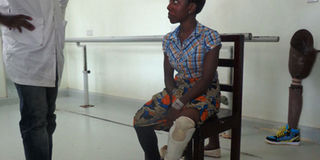You can now have an artificial limb printed for you

Prosthetics made from 3D printing can be easily customised, and created to suit the owner. PHOTO BY Beatrice Nakibuuka
What you need to know:
They say technology never stands still because inventors keep pushing their abilities in quest to improve life as we know it. And for the physically handicapped, a breakthrough in less expensive artificial limbs by way of 3D printing is very many steps in the right direction
Six-year-old Samson Walusimbi is one of the patients at the orthopaedic workshop waiting to get his 3D printed limb. He had a limb that had been made traditionally but it was not fitting well. He had to take it back to get one that fits better.
Walusimbi was taken to Comprehensive Rehabilitation Services in Uganda (CoRSU) by his grandmother Joyce Nakintu after his left foot had got rotten. He injured his foot while he was playing at the age of three but did not get immediate treatment.
His grandmother took him to CoRSU and his leg was amputated.
When he was discharged, his step mother lied about taking the boy to school but when she reached home, she told him to remove the brace shoe that was given to him at the hospital so he would walk barefooted.
The infection spread past the ankle to the calf. By the time his grandmother took him back to CoRSU in 2014, the bone had to be cut off a few inches below the knee. He was using traditionally made prostheses for his left leg since then but it does not fit well so he feels pain while walking.
Walusimbi and many other children that have got post trauma infections, congenital anomalies of no limbs and other orthopeadic conditions gladly wait to use the 3D printed devices to help them live comfortably in society without stigma.
Breakthrough
Perhaps like me, the only time you hear about 3D is in relation to high tech movies. Well, then you will be pleased to learn that this technology is being used to improve the livelihood of the physically handicapped.
After a pilot project in January 2015, which saw more than 30 patients walking comfortably with artificial limbs, the art of 3D printing of prosthetics is becoming a reality in Uganda.
The printing of the prosthetics, according to Mark Ratto, the lead investigator from Canada is faster compared to the traditional method. “3D printed prosthetic is stronger, more flexible, cheaper, durable and we are sensitive to ensure that it fits the patient to add comfort while they use the limb,” says Ratto.
In Uganda, producing a traditional socket involves five to six labour-intensive days and the use of plaster of Paris moulds dried in the sun, causing often ill-fitting sockets, the discomfort of which discourages their use.
The orthopaedic workshop at CoRSU will be the first workshop to produce joint sockets and supporting devices for the people with disabilities.
Canadian researchers from Nia Technologies Inc. and the University of Toronto are field testing 3D innovation with orthopaedic clinicians and young people with disabilities.
How it works
Breakthrough. “We are excited to see how the technology and materials have developed since the research team was last in Uganda,” says Moses Kaweesa, an orthopaedic technologist at CoRSU.
The research, according to Jerry Evans, Nia’s chief executive officer is intended to develop innovations that integrate with current practices and increase efficiency. “Together, we are creating a system that builds on the skills and expertise of orthopaedic clinicians, allowing them to minimise time on manual production and maximise time on decisions about device design, fit and patient care,” says Evans.
The project can be duplicated anywhere at lesser costs, shorter time and with more people with disabilities being helped to use their limbs.
The appropriateness of 3D PrintAbility as a tool for orthopaedic clinicians in resource-limited settings; lies in its strength, durability, fit, and comfort of the devices to children and youth with disabilities.




